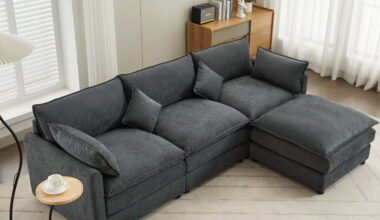People want homes that support the way they live every day, both physically and emotionally. Comfort, health, and peace of mind now matter as much as style. A well-planned home design makes it easier to relax, stay organized, and feel grounded in a space that actually works for the people living in it.
This approach means paying attention to details that go beyond surface-level beauty. It’s about how light enters a room, how spaces are arranged to reduce stress, and how colors affect mood. Even the smallest updates can influence how a home feels. The focus is on building environments that actively contribute to personal well-being and create lasting comfort.
Private Retreats for Renewal
Every house benefits from having spaces where people can step back from daily responsibilities. These private retreats might be a bedroom corner, a cozy nook, or a bathroom designed for relaxation. What matters is having a place that feels like a break from constant activity. It’s where routines slow down, and people can focus on themselves, like in a bathroom.
Working with bathroom remodeling experts often comes up here, because bathrooms are one of the most effective places to build this sense of retreat. Adding better layouts, improving lighting, or updating fixtures can transform a regular bathroom into a space that feels restorative.
Natural Light and Daily Energy
Natural light has a direct effect on how a home feels. A sunlit living room lifts energy during the day, while softer evening light sets the tone for winding down. Spaces that maximize natural daylight naturally promote healthier routines and help connect people to the rhythm of the day.
Design adjustments like larger windows, skylights, or even lighter-colored walls allow light to travel further indoors. Such touches make spaces feel brighter and more open, and they help shape daily patterns. A home filled with natural light naturally supports both productivity and relaxation at the right times.
Reducing Sensory Overload
Homes can sometimes feel overwhelming without people realizing why. Too much noise, clutter, or visual busyness creates stress that builds over time. Reducing sensory overload in design means stripping things back to what feels balanced and manageable. Open layouts, organized storage, and simplified décor all play a part in creating calm spaces.
Sound control is also key to this balance. Using rugs, curtains, or other materials that absorb noise makes shared spaces feel less chaotic. Organizing belongings and avoiding overcrowded surfaces reduces visual clutter.
Calming Color Choices
Color directly affects how people respond to their surroundings. Soft, calming shades often make a space feel more comfortable and welcoming. These tones create consistency and reduce the sharp contrasts that can feel jarring. When used well, color can set the mood of a home and create a steady sense of ease.
A thoughtful approach works best here. Neutral bases paired with gentle accents keep spaces from feeling too stark or too busy. Color doesn’t need to dominate a room—it should complement it. Choosing shades that feel soothing to the eye helps create a flow that ties rooms together while still giving each area its own identity.
Air Quality in Design
Air quality is often overlooked when thinking about home comfort, yet it makes a big difference in daily life. A home with fresh air circulation feels healthier and easier to live in. Dust, humidity, and poor airflow can all create discomfort over time, even in spaces that look perfectly designed.
Simple updates like better ventilation, energy-efficient windows, or plants that filter the air can improve how a home feels. These changes support long-term comfort and contribute to a healthier lifestyle.
Sound Control at Home
Noise plays a bigger role in home life than many people realize. Constant background sounds or echoing rooms can make spaces feel unsettled. Paying attention to how sound travels helps create a calmer atmosphere that supports rest and focus.
Adding elements like rugs, curtains, or wall treatments softens sound and reduces unwanted noise. Even small changes can make living areas, bedrooms, or home offices more peaceful. A home that takes sound into account feels more balanced and promotes a sense of ease throughout the day.
Kitchens That Inspire Healthy Living
A well-thought-out kitchen layout encourages better routines around food and shared time. It becomes a space that supports cooking alongside connection.
When kitchens are functional, organized, and welcoming, they naturally promote healthier choices. Open counters, practical storage, and accessible appliances make it easier to prepare fresh meals. A kitchen designed with both style and function in mind contributes directly to a lifestyle built on well-being.
Spaces for Connection
Beyond private retreats, homes also need areas that bring people together. Living rooms, dining spaces, and outdoor seating areas help build connections between family and friends. These spaces carry a different kind of energy, focused on community and shared experiences.
Designing them with comfort and flow in mind makes gatherings more natural. Furniture arrangements that encourage conversation and layouts that support both small and large groups add to the sense of belonging. A home with spaces designed for connection helps strengthen relationships and create lasting memories.
Movement Through Layout
The way a home is arranged affects how people move through it. Flowing layouts encourage activity and keep spaces from feeling restrictive. This can influence how much people walk, how they use different rooms, and how freely they move during daily routines.
Design elements like open pathways, multi-purpose areas, and flexible layouts create an environment that supports movement without feeling forced. This type of design choice benefits both physical activity and the overall feel of the home. Spaces that guide movement naturally promote healthier and more active living.
Homes That Nurture Over Time
A home creates an environment that supports people through different stages of life. Designing with long-term use in mind means creating spaces that adapt to changing needs. Flexible layouts, durable materials, and thoughtful upgrades all help a house remain comfortable and reliable over the years.
This perspective shifts the idea of home design from short-term style to lasting stability. Homes built or remodeled with resilience in mind continue to support personal well-being, no matter how life changes. It’s about creating a space that feels steady, secure, and adaptable for the long run.
Personal well-being and home design are closely connected. Every choice, from color and light to layout and maintenance, shapes how people feel and function in their homes. Spaces that support rest, connection, and long-term comfort create an environment that truly benefits daily life. When homes are designed with well-being at the core, they become more than just living spaces. They turn into supportive environments that nurture health, comfort, and happiness every day.






